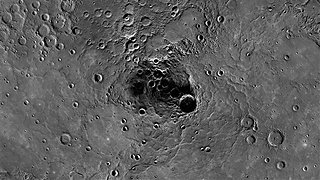
Just in time for Christmas, scientists have confirmed a vast amount of ice at the north pole on Mercury, the closest planet to the sun.
The findings are from NASA's Mercury-orbiting probe, Messenger, and the subject of three scientific papers released Thursday by the journal Science.
The frozen water is located in regions of Mercury's north pole that always are in shadows, essentially impact craters. It's believed the south pole harbors ice as well, though there are no hard data to support it. Messenger orbits much closer to the north pole than the south.
"If you add it all up, you have on the order of 100 billion to 1 trillion metric tons of ice,'' said David Lawrence of the Applied Physics Laboratory at Johns Hopkins University. ``The uncertainty on that number is just how deep it goes.''
The ice is thought to be at least 1.5 feet (0.5 meters) deep and possibly as much as 65 feet (19.8 meters) deep.
There's enough polar ice at Mercury, in fact, to bury an area the size of Washington, D.C., by two to 2.5 miles (4 kilometers) deep, said Lawrence, the lead author of one of the papers.
"These are very exciting results,'' he added at a news conference.
For two decades, radar measurements taken from Earth have suggested the presence of ice at Mercury's poles. Now scientists know for sure, thanks to Messenger, the first spacecraft to orbit Mercury.
The water almost certainly came from impacting comets, or possibly asteroids. Ice is found at the surface, as well as buried beneath a dark material, likely organic.
Messenger was launched in 2004 and went into orbit around the planet 1 year ago. NASA hopes to continue observations well into next year.
Columbia University's Sean Solomon, principal scientist for Messenger, stressed that no one is suggesting that Mercury might hold evidence of life, given the presence of water. But the latest findings may help explain some of the early chapters of the book of life elsewhere in the solar system, he said.
"Mercury is becoming an object of astrobiological interest, where it wasn't much of one before,'' Solomon said.
<관련 한글 기사>
수성에 어마어마한 얼음 발견, 생명체는?
태양과 가장 가까운 행성인 수성의 북극에 어마어마한 양의 얼음이 발견되어 화제다.
이는 나사(NASA)의 수성 무인우주탐사선 “메신저(Messenger)”에 의해 발견되었으며, “사이언스(Science)” 저널에 목요일 자로 게재되었다.
얼음은 수성의 북극에서 발견되었으며 해당 부분은 햇빛을 받는 일이 없다. 수성에는 얼음이 주로 남극에 있다고 추측되었으나 현재 이를 뒷받침할 자료는 없다. 탐사선은 남극보다는 북극에 훨씬 더 가까이서 활동하고 있다.
“수 조 톤에 달하는 얼음이 있습니다.”라고 본 연구의 대표인 존스홉킨스대학교(Johns Hopkins University) 응용과학실험실의 데이비드 로렌스(David Lawrence)가 말했다. “무게를 정확히 모르는 건 얼음의 깊이를 잘 모르기 때문이에요.”
얼음은 최소 0.5미터에서 최대 19.8미터 깊이까지 뻗어있는 것으로 보인다.
수성에는 1km 깊이의 얼음으로 서울 전체를 덮을 만큼의 얼음이 있다고 로렌스가 전했다. 그는 이는 매우 흥미로운 결과라고 말했다.
20여 년 동안 지구에서 쏜 레이저를 통해 수성의 극에 얼음이 있다는 것을 추측해왔으나, 이번 자료로 인해 증명되었다. “메신저”는 수성 궤도를 도는 최초 우주선이다.
수성에 있는 물은 대부분 혜성 또는 소행성에서 왔다. 얼음은 수성의 표면에서 발견되었으며 기타 유기 물질에 의해 덮여있다.
“메신저”는 2004년 발사되었으며 1년 전 수성 근처 궤도에 진입했다. NASA는 내년까지 메신저를 통해 관찰하는 데에 어려움이 없을 것으로 판단하고 있다.
메신저 연구의 수석 과학자인 콜롬비아대학교(Columbia University)의 션 솔로몬(Sean Solomon)은 수성에 물이 존재한다고 해서 생명체도 존재한다고 기대할 수는 없다고 말했다. 그러나 이번 결과는 태양계 내 다른 곳에 생명체가 존재할 지 모른다는 예측을 가능케 한다고 설명했다. 솔로몬은 “수성이 우주생물학의 뜨거운 이슈로 떠올랐습니다. 이전에는 별로 그렇지 않았는데 말이지요.”라고 말했다. (코리아헤럴드)




![[Herald Interview] 'Amid aging population, Korea to invite more young professionals from overseas'](http://res.heraldm.com/phpwas/restmb_idxmake.php?idx=644&simg=/content/image/2024/04/24/20240424050844_0.jpg&u=20240424200058)











![[KH Explains] Korean shipbuilding stocks rally: Real growth or bubble?](http://res.heraldm.com/phpwas/restmb_idxmake.php?idx=652&simg=/content/image/2024/04/25/20240425050656_0.jpg&u=)

